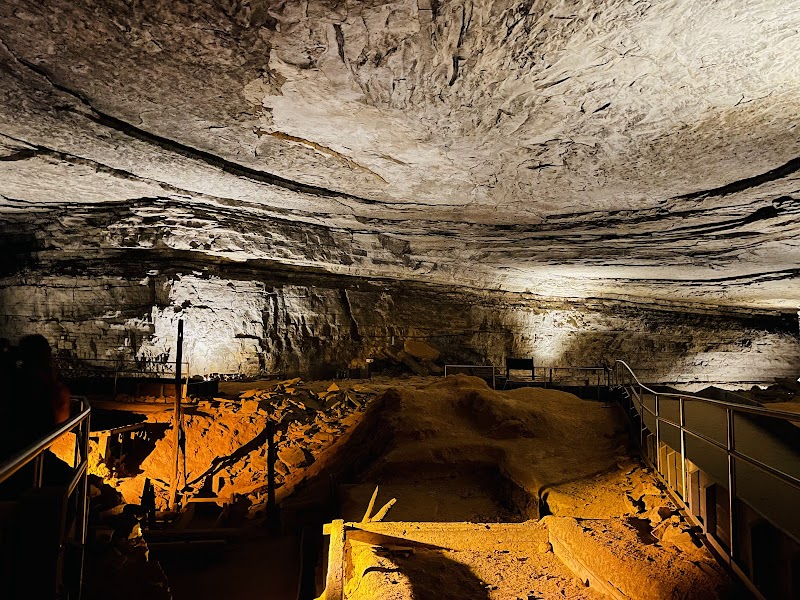
Cave Country Gravel: Bikepacking Routes Around Horse Cave & Mammoth Cave
Bikepack through Kentucky’s Cave Country, where gravel roads twist through limestone hills and shaded forests near Horse Cave and Mammoth Cave. Whether you’re after a challenging day ride or a deeper exploration, this route delivers rugged terrain, panoramic views, and the rich presence of an ancient landscape.
Pack Ample Hydration
Water sources along routes are limited; carry at least two liters and bring a water filter or purification tablets for creek refills.
Choose the Right Tires
Opt for 40-50mm gravel tires with tough sidewalls to handle a mix of coarse gravel and slick mud after rain.
Start Early to Avoid Heat
Begin riding in the early morning to beat afternoon heat and shifting winds that can make open sections tougher.
Download Offline Maps
Cell coverage becomes unreliable on backroads; prepare with a GPS device or offline mapping app to stay on track.
Cave Country Gravel: Bikepacking Routes Around Horse Cave & Mammoth Cave
The rugged terrain surrounding Horse Cave and Mammoth Cave offers a bikepacking challenge that’s as raw as it is rewarding. Stretching across rolling limestone hills and shaded forest corridors, the gravel routes push riders to engage closely with a landscape that moves and breathes alongside you. Expect a patchwork of gravel roads and singletrack weaving through farmland edges, river crossings daring your progress, and unexpected climbs that reveal sweeping views over the Green River valley.
Two prominent routes stand out: the Horse Cave Loop, a manageable 30-mile circuit with about 2,000 feet of elevation gain, perfect for a day trip, and the Mammoth Cave Circuit, a more demanding 50-mile ride pushing toward 4,000 feet in climbs, dipping into quieter backroads.
The gravel is often coarse and compact, but recent rains can turn it into a slick surface making traction a concern. Tires with 40-50mm width tread and good puncture protection are ideal. The terrain toggles between open fields where the wind pushes at your back and shaded forest stretches where shafts of light chase your tire tracks.
Water sources are sparse, so plan to carry at least two liters of water and a purification system if you want to refill from streams. Early spring through fall offers comfortable riding temperatures, but midday summer heat can fight for your energy.
Timing is key: start early to avoid the afternoon sun and headwinds. Footwear that balances durability and ventilation proves critical, as dusty gravel and occasional creek crossings demand fast-drying, secure shoes.
Navigationally, routes often dip onto lesser-marked farm roads. A GPS device or a well-loaded phone app with offline maps will keep you on track. Cell coverage is patchy.
With Mammoth Cave National Park close by, there’s a rich underground story beneath these routes, adding a layer of awe to your ride. Pause at overlooks to watch the interplay of shadow and sunlight on karst formations—a reminder that this landscape shapes itself just as fiercely as you push your pedals.
Each turn brings a fresh encounter: red-winged blackbirds darting over marshes, the river daring you closer with its murmurs, and farm fences lined with wildflowers nodding in the breeze. This is bikepacking that invites respect—not just for your endurance but for the wild persistence of the landscape itself.
Nearby Trips
All Adventures
Boat Charters
Water Activities
Adventures near Horse Cave, Kentucky
Discover the unique and memorable adventures that make Horse Cave, Kentucky special.
Frequently Asked Questions
Are these routes suitable for beginner bikepackers?
The Horse Cave Loop is more accessible for those new to gravel bikepacking, offering moderate elevation and manageable distance. The Mammoth Cave Circuit requires better fitness and technical riding skills due to its length and varied terrain.
Is camping allowed along these routes?
While dispersed camping is limited due to private land, Mammoth Cave National Park offers designated campgrounds nearby. It’s best to plan overnight stays in official spots for both safety and environmental protection.
What wildlife might I encounter while riding?
Riders often spot white-tailed deer, red-winged blackbirds, and at dusk, the occasional gray fox. Birdwatchers may notice migratory birds in season near wetlands and river corridors.
How do I deal with creek crossings?
Most water crossings are shallow but slippery. Using pedals for stable balance and waterproof shoes minimizes risk. Check water levels after rain, as some crossings may become hazardous.
Is night riding recommended on these routes?
Due to limited lighting and tricky navigation, night riding isn’t advisable without experience and proper gear. If you must ride in low light, carry strong front and rear lights and plan your route ahead.
Are there repair stations or bike shops nearby?
Horse Cave has a couple of local bike shops with basic repair services. For extensive repairs, plan to visit larger cities like Glasgow or Bowling Green.
Recommended Gear
Gravel Bike with Wide Tires
A sturdy bike equipped with 40-50mm tires provides the necessary traction and durability for rough gravel and occasional mud.
Hydration System with Filter
Carrying two liters or more with an onboard filter allows refills from natural water sources along the route.
GPS Device or Offline Map App
Limited cell service demands reliable navigation tools to avoid getting lost on lesser-marked routes.
Ventilated, Durable Footwear
Shoes that offer quick drying and solid grip are vital to handle dusty gravel and creek crossings comfortably.
Local Insights
Hidden Gems
- "The overlook near Edmonson Road offers rarely visited vistas of the Green River valley."
- "A hidden spring-fed creek off Hardwood Road provides a peaceful rest spot shaded by ancient oaks."
Wildlife
- "Watch for turkey vultures soaring overhead in thermals during late spring afternoons."
- "Eastern box turtles are common along forest edges, especially during warmer mornings."
History
"The cave country was once a hub for saltpeter mining in the 19th century, supplying materials for early American industries. Local farms trace lineage back to early settlers who shaped much of the current landscape patterns."
